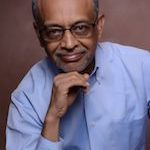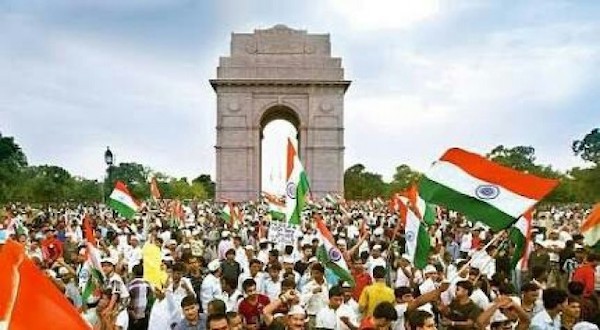
|
India has never faced a severe crisis to its institutions like this one , to its Courts, Media, Election Commission, or law enforcement mechanisms. They are all in danger of losing their independence while the opposition appeared to be withered and infirm. Unless the country wakes up soon to realize the impending danger, the constitutional republic will continue to be undone, and the fabric of liberal democracy unraveled, replacing the idea of India with the idea of Hindutva. |
However, the Modi administration with the blessings from RSS is busy tearing apart the institutional foundations that have kept India a free and democratic nation with individual rights and equal justice. Their actions are reverberating even across the continents as the Hindutva organizations in the United States were celebrating with pomp and ceremony, the laying of the foundation stone for the Temple in Ayodhya.
When Jawaharlal Nehru, India’s first Prime Minister, promoted the “idea of India,” it was supposed to be a grand vision for a nation based on diversity. He has done his utmost institutionalizing that great concept working together with great leaders such as B.R. Ambedkar. However, as we celebrate the 74th anniversary of independence from Britain, the history is being rewritten by the Modi Sarkar and their ardent defenders.
When Nehru made that famous speech on the eve of independence about the “tryst with destiny,” those who felt that religion should be the determinant of nationhood have already left after creating a separate country called Pakistan. The rest of them, including Mahatma Gandhi, rejected the idea of a theocracy but embraced a new vision of “unity in diversity” for people of all religions, regions, castes, and languages.
However, the Modi administration with the blessings from RSS is busy tearing apart the institutional foundations that have kept India a free and democratic nation with individual rights and equal justice. Their actions are reverberating even across the continents as the Hindutva organizations in the United States were celebrating with pomp and ceremony, the laying of the foundation stone for the Temple in Ayodhya. Notwithstanding the role a secular country should play in a religious ceremony, it begs the question as to why the Times Square digital boards must be lit up for a holy ceremony that should have been conducted with piety and devoutness?
To an independent observer, it is not Hinduism or Hindu culture that was celebrated in Times Square, but instead, a message was sent to the Muslims and possibly other minorities that they do not matter in the scheme of things in India anymore. And they are stripped of their place in history and relegated to a second-class status and permanent subjugation. Since August 5 also happened to be the first anniversary of the suspension of the civil liberties in Kashmir, Modi and his acolytes are defiantly conveying to the world that India as a pluralistic democracy has been done and is over with.
The country has been reeling from a COVID-19 crisis with deprivation and miseries all around, especially in rural villages and towns where businesses are shut, and the poor laborers are out of work. The Modi government appears detached and unconcerned while going about their ways to carry on with their saffron agenda. The forces they have unleashed on the nation have started dictating what we should think or say or what is edible to eat. A sense of fear pervades the society now that even expressing an opinion on social media could invite the wrath of the enforcement directorate or other law enforcement authorities.
The passing of CAA has brought millions of ordinary people into the streets protesting the discriminatory nature of its provisions based on religion. There were great concerns that CAA, for the first time, has injected the religious component into legislation to differentiate and stigmatize people. At Shaheen Bagh, a neighborhood in South-eastern Delhi, hundreds of people turned up over nine weeks to take part in an indefinite sit-in until COVID stepped in to prevent its continuation.. Although they were peaceful protests, BJP had no stomach for tolerating any dissent.
What followed is Delhi riots, and for two days, Delhi police watched passively while rampaging mobs killed, looted, and torched a whole neighborhood. The common refrain was, “teach them a lesson.” Some of the BJP leaders were openly giving inflammatory speeches promoting the riots and defending the culprits. The riots have a lot of similarity to the 2002 pogrom in Gujarat in terms of its ferocity, police complicity, and political patronage, and appeared to be more strategy-driven to divide and polarize the community to expand their reach and retain power. Today, the narrative is being rewritten to absolve the criminal elements and frame and punish those who have advocated for fairness and equal justice under the law.
Since independence, the Supreme Court has remained a firewall against abuse of power by the Executive branch and the ruling class elites. The integrity of judges has been a critical component in rendering impartial decisions that have far-reaching effects on society. Judicial independence is vital in reassuring the public that judges would dispense cases with honesty and impartiality in accordance with the law and evidence presented to them. The Supreme court must be free of fear and favor from the Executive; if and only if that is the case will the Court be trusted by the public.
It appears no longer the case as a tamed Supreme Court that has been rendering decisions in accordance with Government’s wishes. Although the country has welcomed the Ayodhya verdict, the paradox is not lost on anyone. The Supreme Court’s decision to punt the outright violations of the civil rights of the Indian citizens in Kashmir has further stained the reputation of the Supreme court as an independent arbiter who could protect the lives and property of the citizenry or safeguard their civil rights.
India’s free and vibrant press played a critical role in protecting India’s democracy since its independence. But journalists around the country now feel that they are also under attack. The fourth Estate, as they are dubbed, has an important role to play as regards disseminating information with objectivity and holding the public officials accountable for their actions. Since Modi came to power, his Government has tried to control the news media by berating editors, cutting advertisements, ordering tax investigations, and encouraging their capitalist cronies to acquire the media entities so that they could help build a cult of personality that portrays Modi as the nation’s savior.
India has never faced a severe crisis to its institutions like this one to its Courts, Media, Election Commission, or law enforcement mechanisms. They are all in danger of losing their independence while the opposition appeared to be withered and infirm. Unless the country wakes up soon to realize the impending danger, the constitutional republic will continue to be undone, and the fabric of liberal democracy unraveled, replacing the idea of India with the idea of Hindutva.
(The author is a former Chief Technology Officer of the United Nations and the Vice-Chairman of the Indian Overseas Congress, USA)
